River Rye, Rievaulx 26 April 2005
led by Gordon Woodroffe; photos by Nan Sykes & Tom Denney
Nine stalwart members met at Rievaulx Bridge on a rather damp and murky morning – a great pity as it was almost the only bad day of the whole week! However, our spirits quickly lifted when we realised this was going to be an otter hunt.
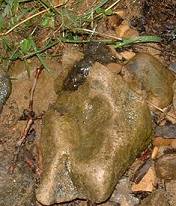 Gordon explained that he had spent many hours over the years monitoring this particular stretch of the river, amongst others, for signs of otters, and he hoped to be able to show us evidence of their presence. He outlined the kinds of places to look, such as exposed tangles of tree roots under overhanging vegetation along the bank, tree roots and stones raised up in just the right way to attract an otter to leave its “spraint”, and fine sand along the water’s edge which might show footprints. (Photo right shows spraint over a stone.)
Gordon explained that he had spent many hours over the years monitoring this particular stretch of the river, amongst others, for signs of otters, and he hoped to be able to show us evidence of their presence. He outlined the kinds of places to look, such as exposed tangles of tree roots under overhanging vegetation along the bank, tree roots and stones raised up in just the right way to attract an otter to leave its “spraint”, and fine sand along the water’s edge which might show footprints. (Photo right shows spraint over a stone.)
As we set off downstream we heard an unfamiliar “skreek” from a bird flying rapidly along the river. Later we heard it again, then spotted the caller: a dipper, which landed on some stones and showed us just why it got its name. A lovely bird, and very good to see it thriving here, as dipper numbers in general are in decline. We also saw a pair of grey wagtails, in very smart fresh breeding plumage, running about in the shallows chasing insects. Otherwise most of the birds were heard rather than seen, though we did spot both swallows and house martins, as well as a tawny owl apparently on the nest in a tree-trunk, and were surprised by a duck flying rapidly away; so fast we couldn’t identify it, but it certainly wasn’t a mallard as its call was more like a bark than a quack.
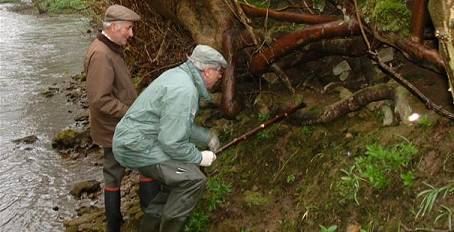
The kind of place otters frequent, and (right) footprints in the sand
(note especially just to the right of the stone in the foreground) |
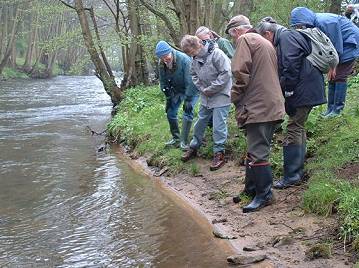 |
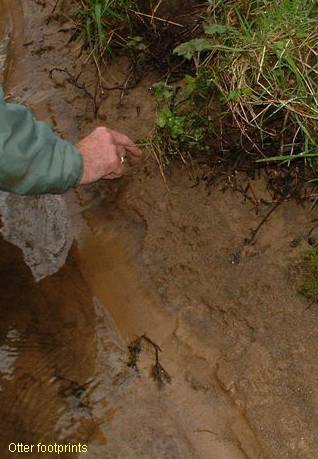 Gordon kept disappearing under the bank to prospect for otter signs and in some cases he waded out into the middle of the river or even over to the the far bank, but for some time found nothing positive. However, we then struck lucky, when he found some relatively fresh spraint in amongst some tree roots (above left), and then just a little further along we spotted footprints (well done, Andrea!). When we looked closely we could see a whole set of prints suggesting that an otter had walked right along the edge of the water, probably earlier that morning. The prints showed 4 clear toes, rounded and quite widely spaced, but no marks from the relatively short claws. It was a real thrill to see these prints, which Gordon thought were probably those of an adult female. We found more prints further downstream, probably made by the same individual. We also saw one splendid brown trout – no doubt this is what the otters are looking for too.
Gordon kept disappearing under the bank to prospect for otter signs and in some cases he waded out into the middle of the river or even over to the the far bank, but for some time found nothing positive. However, we then struck lucky, when he found some relatively fresh spraint in amongst some tree roots (above left), and then just a little further along we spotted footprints (well done, Andrea!). When we looked closely we could see a whole set of prints suggesting that an otter had walked right along the edge of the water, probably earlier that morning. The prints showed 4 clear toes, rounded and quite widely spaced, but no marks from the relatively short claws. It was a real thrill to see these prints, which Gordon thought were probably those of an adult female. We found more prints further downstream, probably made by the same individual. We also saw one splendid brown trout – no doubt this is what the otters are looking for too.
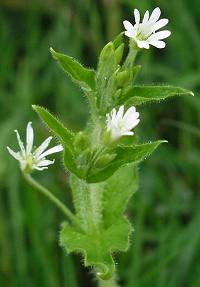
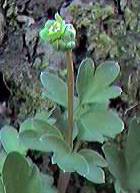 From a botanical point of view this was also an interesting site, although with the late spring not many species were actually in bloom. One small plant intrigued us for quite a while until we found a specimen with open flowers and identified it as water chickweed (Myosoton aquaticum (left)), which is not common – although just here the conditions clearly suited it and it carpeted the ground. There was also a patch of wetland alongside the river a little further downstream with so-called bulrush (reedmace Typha latifolia), rushes and water figwort together with at least two sedges: the greater pond sedge Carex riparia and the primeval-looking tussock sedge C. paniculata. This grows in large tussocks which gradually become taller each year (photo below). The size of some of these plants suggests they might be 100 years old! The final highlight from my point of view was finding the delightful moschatel or town hall clock (Adoxa moschatellina, right) growing right by the roadside where we had parked the cars.
From a botanical point of view this was also an interesting site, although with the late spring not many species were actually in bloom. One small plant intrigued us for quite a while until we found a specimen with open flowers and identified it as water chickweed (Myosoton aquaticum (left)), which is not common – although just here the conditions clearly suited it and it carpeted the ground. There was also a patch of wetland alongside the river a little further downstream with so-called bulrush (reedmace Typha latifolia), rushes and water figwort together with at least two sedges: the greater pond sedge Carex riparia and the primeval-looking tussock sedge C. paniculata. This grows in large tussocks which gradually become taller each year (photo below). The size of some of these plants suggests they might be 100 years old! The final highlight from my point of view was finding the delightful moschatel or town hall clock (Adoxa moschatellina, right) growing right by the roadside where we had parked the cars.
In conclusion, despite the weather this was a very rewarding trip. Tom Denney thanked Gordon on our behalf for showing us this interesting stretch of river and sharing his expertise on otters in particular and the wildife of the area in general. My thanks also to Nan Sykes for identifying the plants, including difficult ones such as the sedges.
The photo below shows Tussock Sedge.
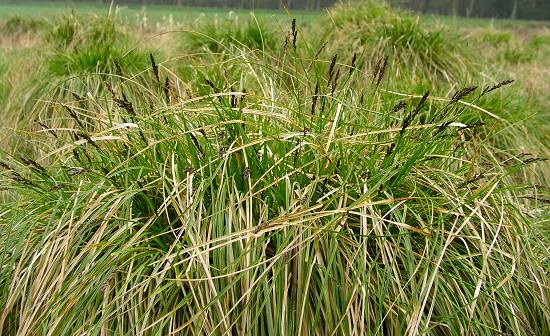
Species lists
Birds
Birds seen or heard included: chiffchaff, blackbird, song thrush, wood pigeon, wren, chaffinch, robin, goldcrest, marsh tit, grey wagtail, dipper, moorhen, rook, jackdaw, swallow, house martin, blackcap, tawny owl, and a mystery duck.
Back to the top
Mammals
Rabbit, roe deer (single male), otter footprints, shrew (? – lots of high pitched squeaking in the undergrowth)
Plants
| Acer campestre |
Maple, field |
| Acer pseudoplatanus |
Sycamore |
| Adoxa moschatellina |
Moschatel or Town hall clock |
| Aegopodium podagraria |
Ground elder |
| Alchemilla sp. |
Ladys mantle |
| Alliaria petiolata |
Hedge Garlic or Jack by the Hedge |
| Allium ursinum |
Ramsons |
| Alnus glutinosa |
Alder |
| Anemone nemorosa |
Wood Anemone |
| Angelica sylvestris |
Angelica |
| Anthriscus sylvestris |
Cow parsley |
| Arum maculatum |
Lords and ladies |
| Bellis perennis |
Daisy |
| Betula pendula |
Birch, silver |
| Caltha palustris |
Marsh marigold |
| Carex riparia |
Greater Pond sedge |
| Carex paniculata |
Tussock sedge |
| Cerastium fontanum |
Mouse ear, common |
| Chrysosplenium oppositifolium |
Golden saxifrage, opposite leaved |
| Cirsium arvense |
Thistle, creeping |
| Cirsium palustre |
Thistle, marsh |
| Cirsium vulgare |
Thistle, spear |
| Corylus avellana |
Hazel |
| Crataegus monogyna |
Hawthorn |
| Epilobium hirsutum |
Willowherb, great |
| Filipendula ulmaria |
Meadowsweet |
| Equisetum fluviatile |
Water Horsetail |
| Fraxinus excelsior |
Ash |
| Geranium pratense |
Cranesbill, meadow |
| Glechoma hederacea |
Ground ivy |
| Hedera helix |
Ivy |
| Heracleum sphondylium |
Hogweed |
| Juncus effusus |
Soft Rush |
| Juncus inflexus |
Hard Rush |
| Larix sp. (L. decidua) |
Larch |
| Luzula sylvatica |
Woodrush, great |
| Mercurialis perennis |
Dogs mercury |
| Myosotis arvensis |
Forgetmenot, field |
| Myosoton aquaticum |
Water chickweed |
| Myrrhis odorata |
Sweet cicely |
| Oxalis acetosella |
Wood sorrel |
| Petasites hybridus |
Butterbur |
| Plantago major |
Plantain, greater |
| Potentilla sterilis |
Barren Strawberry |
| Primula vulgaris |
Primrose, common |
| Prunus avium |
Wild Cherry |
| Prunus spinosa |
Blackthorn |
| Quercus sp. |
Oak |
| Ranunculus ficaria |
Celandine, lesser |
| Ribes uva-crispa |
Gooseberry |
| Rosa sps. (probably canina) |
Rose, dog |
| Rubus fruticosus |
Bramble |
| Rubus idaeus |
Raspberry |
| Rumex obtusifolius |
Dock, broad leaved |
| Salix caprea (probably) |
Willow, goat |
| Salix alba (probably) |
Willow, white |
| Scrophularia auriculata |
Figwort, water |
| Silene sp |
Campion (leaves) |
| Stachys arvensis |
Field Woundwort |
| Taraxacum sp. |
Dandelion |
| Trifolium repens |
Clover, white |
| Tussilago farfara |
Coltsfoot |
| Typha latifolia |
Reedmace, common |
| Ulmus glabra |
Elm, wych |
| Urtica dioica |
Nettle, common |
65spp.
© Ryedale Natural History Society 2005
Plant photos
© Nan Sykes 2005; other photos © Tom Denney 2005 |
Gill Smith, April 2005 |
Back to the Index page
 Gordon explained that he had spent many hours over the years monitoring this particular stretch of the river, amongst others, for signs of otters, and he hoped to be able to show us evidence of their presence. He outlined the kinds of places to look, such as exposed tangles of tree roots under overhanging vegetation along the bank, tree roots and stones raised up in just the right way to attract an otter to leave its “spraint”, and fine sand along the water’s edge which might show footprints. (Photo right shows spraint over a stone.)
Gordon explained that he had spent many hours over the years monitoring this particular stretch of the river, amongst others, for signs of otters, and he hoped to be able to show us evidence of their presence. He outlined the kinds of places to look, such as exposed tangles of tree roots under overhanging vegetation along the bank, tree roots and stones raised up in just the right way to attract an otter to leave its “spraint”, and fine sand along the water’s edge which might show footprints. (Photo right shows spraint over a stone.)

 Gordon kept disappearing under the bank to prospect for otter signs and in some cases he waded out into the middle of the river or even over to the the far bank, but for some time found nothing positive. However, we then struck lucky, when he found some relatively fresh spraint in amongst some tree roots (above left), and then just a little further along we spotted footprints (well done, Andrea!). When we looked closely we could see a whole set of prints suggesting that an otter had walked right along the edge of the water, probably earlier that morning. The prints showed 4 clear toes, rounded and quite widely spaced, but no marks from the relatively short claws. It was a real thrill to see these prints, which Gordon thought were probably those of an adult female. We found more prints further downstream, probably made by the same individual. We also saw one splendid brown trout – no doubt this is what the otters are looking for too.
Gordon kept disappearing under the bank to prospect for otter signs and in some cases he waded out into the middle of the river or even over to the the far bank, but for some time found nothing positive. However, we then struck lucky, when he found some relatively fresh spraint in amongst some tree roots (above left), and then just a little further along we spotted footprints (well done, Andrea!). When we looked closely we could see a whole set of prints suggesting that an otter had walked right along the edge of the water, probably earlier that morning. The prints showed 4 clear toes, rounded and quite widely spaced, but no marks from the relatively short claws. It was a real thrill to see these prints, which Gordon thought were probably those of an adult female. We found more prints further downstream, probably made by the same individual. We also saw one splendid brown trout – no doubt this is what the otters are looking for too.
 From a botanical point of view this was also an interesting site, although with the late spring not many species were actually in bloom. One small plant intrigued us for quite a while until we found a specimen with open flowers and identified it as water chickweed (Myosoton aquaticum (left)), which is not common – although just here the conditions clearly suited it and it carpeted the ground. There was also a patch of wetland alongside the river a little further downstream with so-called bulrush (reedmace Typha latifolia), rushes and water figwort together with at least two sedges: the greater pond sedge Carex riparia and the primeval-looking tussock sedge C. paniculata. This grows in large tussocks which gradually become taller each year (photo below). The size of some of these plants suggests they might be 100 years old! The final highlight from my point of view was finding the delightful moschatel or town hall clock (Adoxa moschatellina, right) growing right by the roadside where we had parked the cars.
From a botanical point of view this was also an interesting site, although with the late spring not many species were actually in bloom. One small plant intrigued us for quite a while until we found a specimen with open flowers and identified it as water chickweed (Myosoton aquaticum (left)), which is not common – although just here the conditions clearly suited it and it carpeted the ground. There was also a patch of wetland alongside the river a little further downstream with so-called bulrush (reedmace Typha latifolia), rushes and water figwort together with at least two sedges: the greater pond sedge Carex riparia and the primeval-looking tussock sedge C. paniculata. This grows in large tussocks which gradually become taller each year (photo below). The size of some of these plants suggests they might be 100 years old! The final highlight from my point of view was finding the delightful moschatel or town hall clock (Adoxa moschatellina, right) growing right by the roadside where we had parked the cars.